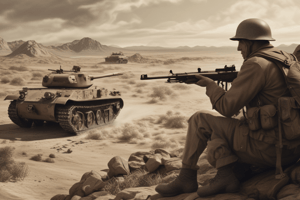Podcast
Questions and Answers
How did war affect America's economy?
How did war affect America's economy?
- Factories closed down
- Unemployment rose rapidly
- Unemployment fell rapidly (correct)
- Government spending decreased
What was the unemployment rate in America by 1944?
What was the unemployment rate in America by 1944?
1.4%
Why did the American industry expand during WWII?
Why did the American industry expand during WWII?
Roosevelt called leading industrialists for advice on wartime production demands.
What was the effect of conscription on the American workforce during WWII?
What was the effect of conscription on the American workforce during WWII?
What was one result of military spending after WWII?
What was one result of military spending after WWII?
What effect did the growth in population have on American consumerism?
What effect did the growth in population have on American consumerism?
By 1960, 90% of homes in America had TV sets.
By 1960, 90% of homes in America had TV sets.
What factor made mortgages affordable for many young couples post-war?
What factor made mortgages affordable for many young couples post-war?
The standard of living in America was ___ times that of an average Briton.
The standard of living in America was ___ times that of an average Briton.
What societal issue affected many Black Americans after WWII?
What societal issue affected many Black Americans after WWII?
Flashcards are hidden until you start studying
Study Notes
Economic Impact of WW2
- Unemployment dropped significantly; by 1944, it plummeted to 1.4%.
- 17 million jobs were created as factories shifted to war production.
- Demand and prices for U.S. farm products saw substantial increases.
- Government spending doubled to support wartime efforts, including military expenditures.
- About 16 million Americans were conscripted into the armed forces.
- Traditional industries thrived due to government contracts for war supplies.
Expansion of American Industry
- Roosevelt engaged top industrialists for advice on enhancing wartime production, such as General Motors producing machine guns.
- The Lend-Lease program significantly contributed to industrial growth, positioning the U.S. as the world's leading economic power by 1960.
- Conscription saw 16 million Americans in service; 4 million workers migrated north to fill factory jobs.
- Female workforce participation increased by 50% during the war.
Post-War Industrial Development
- Billions were allocated to military research and development, fueling economic growth.
- The Cold War spurred a surge in defense spending.
- European demands kept U.S. production levels high, aiding economic recovery.
- By the late 1940s, America produced half of the world's manufactured goods, driving extensive job creation in sectors like aircraft production and food processing.
Affluence and Consumerism
- American consumers utilized approximately $100 billion in savings accumulated during the war.
- Hire purchase and consumer credit systems facilitated immediate purchasing, supporting a culture of "buy now, pay later."
- Population growth resulted in increased demand for various goods and services.
Standard of Living
- American living standards were three times higher than those of an average British citizen.
- Shopping emerged as a popular recreational activity reflecting consumer culture.
- Modern amenities became standard expectations in new homes, including technologies like television.
- By 1960, 90% of American households possessed TV sets.
Suburbanization Trends
- Suburbs symbolized the American Dream, especially for young couples.
- Affordable housing coupled with low-interest rates made homeownership attainable through mortgages.
- Post-war economic prosperity led to a boom in spending power.
- The baby boom from 1945 to 1960 resulted in a 40 million population increase, escalating the demand for new housing.
Socioeconomic Flaws
- Many Black Americans continued to experience poverty and exclusion from economic prosperity.
- In 1959, 29% of the U.S. population lived in poverty, highlighting socioeconomic disparities.
- By 1955, 40% of welfare recipients in New York were African Americans.
- The U.S. lagged in developing effective pension and welfare systems, particularly as medical care costs climbed.
Studying That Suits You
Use AI to generate personalized quizzes and flashcards to suit your learning preferences.




